Research
Introduction
We are interested in mathematical modeling of real world problems, through studies combining
rigorous mathematical analysis and computational simulations of high fidelity. Such studies offer
insights into the basic mechanisms of the dynamics and function of the physical processes and provide a
foundation for new mathematical tools and numerical algorithms to complement experimental research. Our
research has been partially supported by Simons Foundation,
NIH through the joint DMS/NIGMS Initiative, and
National Science Foundation.
We develop and implement numerical methods for solving partial differential equations defined on manifolds, with internal interfaces, or coupled through dynamical boundaries.
We use the following software packages in some of our simulations:
We develop and implement numerical methods for solving partial differential equations defined on manifolds, with internal interfaces, or coupled through dynamical boundaries.
We use the following software packages in some of our simulations:
- Finite element methods: FETK
- Finite difference methods: MIBPB
- Molecular dynamics simulations: NAMD
- Mesh generation: MSMS | NETGEN | TETGEN
- Visulization: MATLAB | ParaView | VMD
General Research Interests
- Numerical Analysis; Applied Analysis; Scientific Computing
- Mathematical Biophysics
- Fluid Mechanics
Current Projects
1. Electrodiffusion in solvated biomolecular systems
-
Electrodiffusion is an essential process in biological systems. Motion of freely dissolved ions and biomolecules is governed by diffusion, the random motion of molecules that results from thermal fluctuations. Presence of deterministic weak forces to the system merely add a slight bias to the random motion. In biomolecular system this force is mostly the electrostatic force because mobile ions and most biomolecules are (weakly) charged. The diffusion with drift provided by the electrostatic force is called electrodiffusion.
We are interested in the electrodiffusion in the bulk (i.e., the 3-D domain or its 2-D reduction) or on the surface (closed or open). In particular we study the continuous distributions in the bulk or on the surfaces of charged particles with discrete features (finite sizes, particle-particle interactions). Important biological and medical conclusions can be drawn from these distributions, for instance- Which proteins could induce favorable electrodiffusion of specified ions or ligands?
- What is the reaction rate at particular spot on the molecular surface?
- What is the dynamics of the electrodiffusion or the reaction if the geometry, boundary conditions, or the composition of the particle system is changed?
Example I
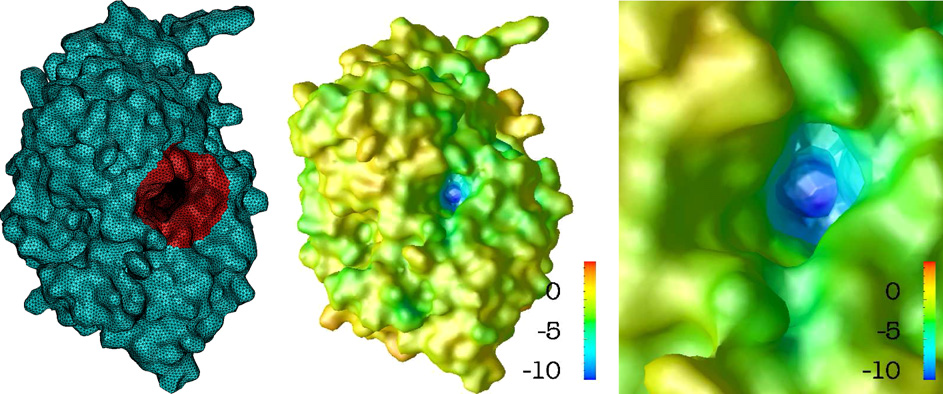 AChE [Wiki: Acetylcholinesterase] is an enzyme that serves to terminate the synaptic transmission by degrading the neurotransmitter acetylcholine, and can be found at the synaptic membranes in neuromuscular junctions and cholinergic nervous system. This pictures shows a discretized molecular surface of AChE with the region around the reaction center colored red (left), a map of the electrostatic potential on the surface (middle), and the surface potential around the degrading chemical reaction center (right). Positively charged neurotransmitter acetylcholines diffuse in the solution, and will be attracted to the negatively charged reaction center.Example II
AChE [Wiki: Acetylcholinesterase] is an enzyme that serves to terminate the synaptic transmission by degrading the neurotransmitter acetylcholine, and can be found at the synaptic membranes in neuromuscular junctions and cholinergic nervous system. This pictures shows a discretized molecular surface of AChE with the region around the reaction center colored red (left), a map of the electrostatic potential on the surface (middle), and the surface potential around the degrading chemical reaction center (right). Positively charged neurotransmitter acetylcholines diffuse in the solution, and will be attracted to the negatively charged reaction center.Example II
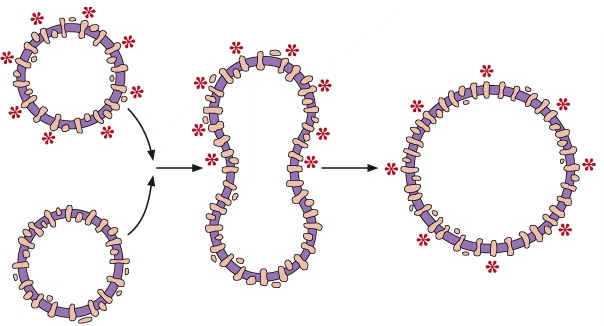 The picture illustrates the lateral diffusion on membrane. The plasma membrane is shown as two parallel lines (representing the lipid portion) in which proteins are embedded. Two cells are fused in the figure. Sometime after the fusion of the cell membranes, the fluorescent-marked proteins of in the labeled cell spreads to the entire surface of the fused cells. This spreading can be described as a lateral diffusion on a dynamical surface.Example III
The picture illustrates the lateral diffusion on membrane. The plasma membrane is shown as two parallel lines (representing the lipid portion) in which proteins are embedded. Two cells are fused in the figure. Sometime after the fusion of the cell membranes, the fluorescent-marked proteins of in the labeled cell spreads to the entire surface of the fused cells. This spreading can be described as a lateral diffusion on a dynamical surface.Example III
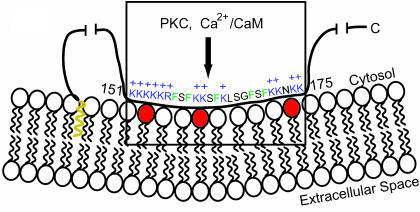 This is a cartoon of the local sequestration of negatively charged lipid headgroups (red circles) by the positively charged peptide which is tethered to the membrane at its N-terminal (yellow) [Biophys J. 86: 2188-2207; 2004]. Without the peptide the charged lipids are uniformly distributed on the membrane. These lipids aggregate to the underneath of the peptide through surface electrodiffusion.
This is a cartoon of the local sequestration of negatively charged lipid headgroups (red circles) by the positively charged peptide which is tethered to the membrane at its N-terminal (yellow) [Biophys J. 86: 2188-2207; 2004]. Without the peptide the charged lipids are uniformly distributed on the membrane. These lipids aggregate to the underneath of the peptide through surface electrodiffusion. 2. Electromechanical modeling for macromolecular interactions
-
Deformation of biomolecules and their assembles is fundamental to many biological processes, and occurs over a wide range of spatial and temporal scales. Despite tremendous achievements made in discrete methods such as molecular dynamics (MD), Monte Carlo (MC) and Brownian dynamics (BD), accompanying the rapid increase of computing power, it remains a significant challenge for these methods to study conformational changes over 10-100nm or occurring on time-scales beyond a microsecond. The current computational trend is obtained by introducing continuum descriptions of material behavior and applying them at macroscopic level. Bilayer lipid membrane, double-helix DNA and those biomolecules that have large characteristic spatial scale and high symmetry are all appropriate mechanical structures for developing continuum-based or multiscale approaches.
Example IV
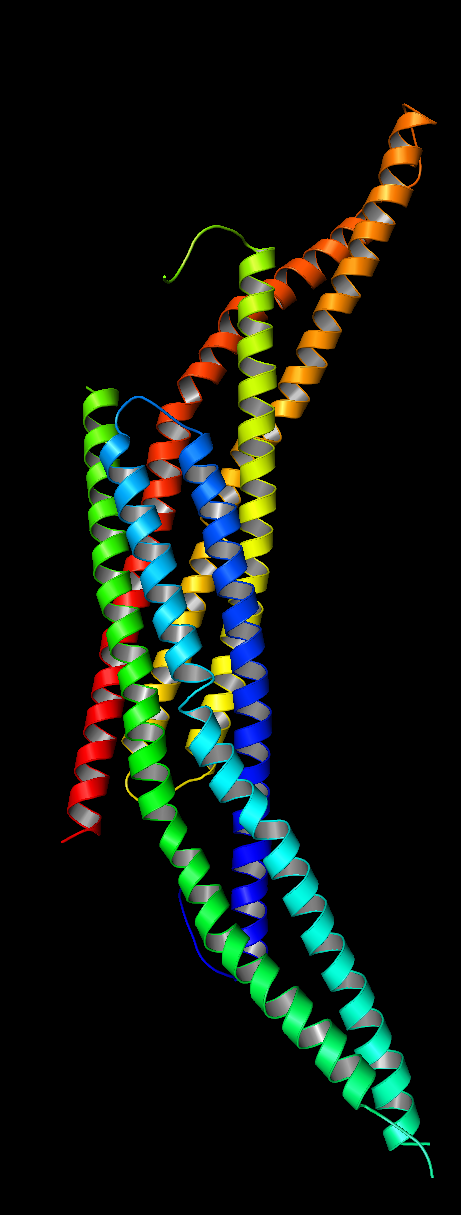
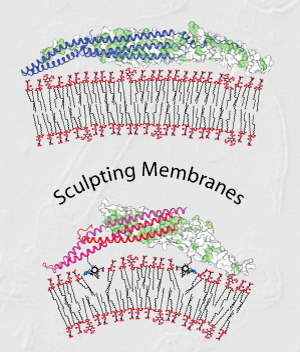
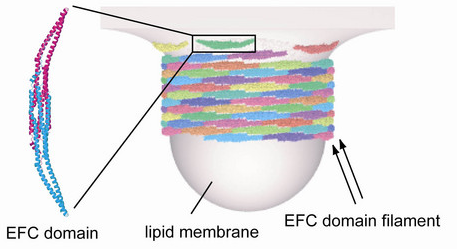 BAR proteins [ Wiki: BAR Domain | BAR Super Family ] is a family of proteins with highly conserved dimerisation domains that have distinct intrinsic curvatures. BAR domain proteins are involved in many membrane dynamics in a cell. In a typical case a BAR protein binds to membrane with a particular curvature or induces a particular curvature when its binds to the membrane. This is made possible mainly by the electrostatic interactions between the BAR protein and the membrane. Cooperatives actions of many BAR domains can induced a very large membrane curve, finally leading the membrane buckling or vesiculation that is necessary for cell endocytosis [Wiki: endocytosis | Animation of endocytosis | A leading research group in endocytosis] and exocytosis. Quantitative determination of the equilibrium state or the dynamics of these interactions involves accurate solutions of electrostatic forces at dynamic membrane surfaces and the membrane deformation subject to these forces. Additional modeling and numerical difficulties will be added if the BAR domain protein contact with or insert into the membrane during the interactions.
BAR proteins [ Wiki: BAR Domain | BAR Super Family ] is a family of proteins with highly conserved dimerisation domains that have distinct intrinsic curvatures. BAR domain proteins are involved in many membrane dynamics in a cell. In a typical case a BAR protein binds to membrane with a particular curvature or induces a particular curvature when its binds to the membrane. This is made possible mainly by the electrostatic interactions between the BAR protein and the membrane. Cooperatives actions of many BAR domains can induced a very large membrane curve, finally leading the membrane buckling or vesiculation that is necessary for cell endocytosis [Wiki: endocytosis | Animation of endocytosis | A leading research group in endocytosis] and exocytosis. Quantitative determination of the equilibrium state or the dynamics of these interactions involves accurate solutions of electrostatic forces at dynamic membrane surfaces and the membrane deformation subject to these forces. Additional modeling and numerical difficulties will be added if the BAR domain protein contact with or insert into the membrane during the interactions. 3. Multiflow in geodynamics
-
Water flows. Oil flows. Lava flows. Rock flows, well, true, in geologic time scale.
A wide variety of geodynamic processes can be modeled as highly viscous creeping flows. These processes usually involve viscous, non-Newtonian visco-elastic, viscoplastic, or visco-elasto-plastic rheologies. Of our particular interest is the convection in Earth’s mantle that occurs at depths ranging from about 100 km to 2900 km. The rocks within Earth’s mantle behave visco-plastically over geologic time scales (thousands to millions of years), and behave elasto-plastically over time scales associated with the earthquake cycle and seismic wave propagation (seconds to hundreds of years). The strength of mantle rocks varies with depth, with the elastic and viscous behaviors being different. The elastic moduli increase monotonically with depth, due primarily to the increasing pressure, with the shear modulus ranging approximately from 60 to 300 GPa and the bulk modulus ranging from about 100 to 600 GPa. The viscous behavior is more complicated, and shows abrupt change at some particular depths underground. We are working on modeling these creeping flows which extremely large viscosity contrast.
Example V
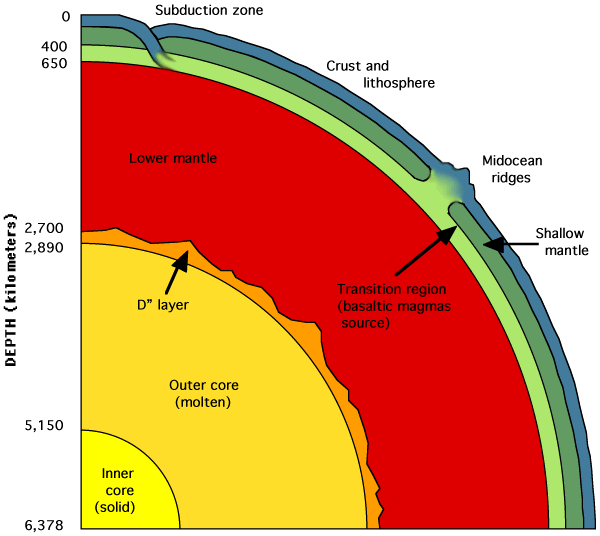
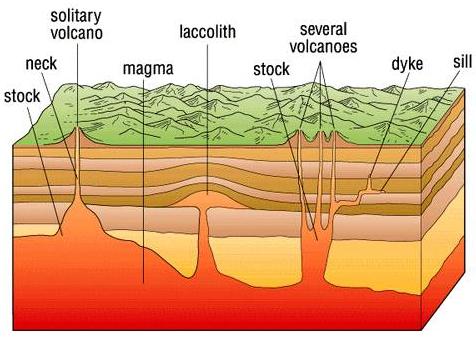
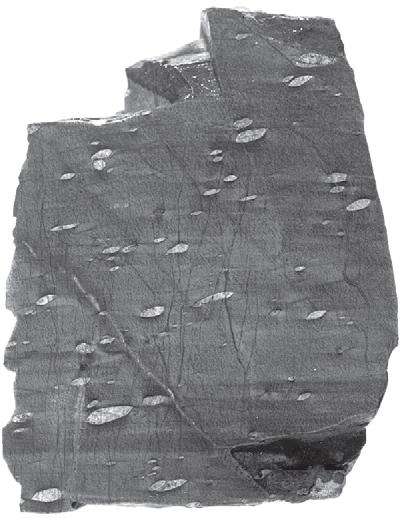 The planet Earth [Wiki: Structure of the Earth] is made up of three main shells: the very thin, brittle crust, the mantle, and the core; the mantle and core are each divided into two parts, c.f. the left figure.
The planet Earth [Wiki: Structure of the Earth] is made up of three main shells: the very thin, brittle crust, the mantle, and the core; the mantle and core are each divided into two parts, c.f. the left figure.
Plate tectonic movements may induce subduction zone, where one tectonic plate moves under another tectonic plate, sinking into the Earth's mantle. On the other hand, rocks at shallow level will rise during the convection of solid mantle, experiencing a process termed decompression melting if they rise far enough. This is an important source of magma. These magma usually converge to magma chambers, c.f. the middle figure.
Magma chambers are usually deep underground [Explorers descend 650ft into magma chamber for the first time], but some are very close to the ground surface [Magma chamber surprisingly close to Hawaii's surface?]. A volcanic eruption begins when pressure on a magma chamber forces magma up through the conduit and out the volcano's vents. Think about the contrast of the viscosity and density of the rock and the elting magma flows inside.
The right figure shows the particles included in a rock. The inclusion is formed at the time when the melting particles flow with the shear flow of the melting rock. The systematic inclinations exhibited in these isolated rigid clasts can give us useful information to decipher the kinematic history and mechanical behavior of the region. This problem is at the low end of the scale range of our study of multiflows in geodynamics.